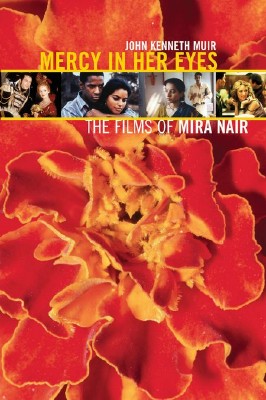 My monograph on independent filmmaker Mira Nair (Salaam Bombay!, Monsoon Wedding, Vanity Fair, The Namesake...) Mercy in Her Eyes: The Films of Mira Nair, has just hit bookstores and the press in India!
My monograph on independent filmmaker Mira Nair (Salaam Bombay!, Monsoon Wedding, Vanity Fair, The Namesake...) Mercy in Her Eyes: The Films of Mira Nair, has just hit bookstores and the press in India!Here are some of the highlights so far. From The Hindu (India's national newspaper) is a piece by S. Theodore Baskaran entitled "Cultural Crossover Oeuvre." It reads in part:
Muir, who has examined the films of Sam Raimi in an earlier work, looks at Nair's films in this book. He sees Nair's films in the backdrop of globalisation. Observing her unique style and her concerns, Muir identifies her as an auteur, fitting in with this French theory of film study. Nair's major concern that gets reflected in her films is one of identity. Her characters face the questions: What makes me who I am? What makes me unique? She turns her lens on exiles, expatriates, outsiders, and `nowhere' people. Muir concludes that her "films reflect and represent her own personal experiences, political and social views, and even general perceptions of life itself. Nair's films so often represent love letters to the India she knows and adores, an India that globalisation could imperil, or at the very least, substantially alter. This is why she is truly a local filmmaker, but one whose audience is global." He points out that Nair is able to capture not merely the place and a time but a texture and a feeling. This is exemplified by many sequences in `Missisipi Masala'.
The author of this book, Muir, has not only analysed her films but have spoken with those who worked in her films, such as Dr. Abraham Varghese, author of `My Own Country', actor Naveen Andrews and Delhi-based theatre person, Barry John, an early and lasting influence on Mira Nair.
Muir, an independent film scholar, explains film studies concepts in a language that is reader-friendly and engaging. Though one misses a complete filmography of Mira Nair, there is an insightful appendix, which provides a point-by-point textual analysis of her feature films. It provides a model for film analysis. An elaborate bibliography and an exhaustive index increase the utility of this work. This delightful book is bound to stimulate interest in film studies in India."
At The Financial Express, Editor Sudipta Datta (a delightful journalist whom I had the opportunity to correspond with...), writes in her article "Local stories, Universal resonance" that "John Kenneth Muir has drawn an engaging portrait of Mira Nair as seen through her films."
"What emerges is an interesting portrait of an artist, who has “focused dramatically on the subjects of national and personal identity, and more importantly, the quandary of characters who have departed their home only to find that in their new lives, they are traversing uncharted waters…” It’s about an artist who has succeeded in the global market by “remaining committed to her art even in the face of temptations that other directors might find irresistible (she famously refused to direct a Harry Potter film).” At least in four of her films, she has had to struggle to get finances.
Muir also peppers the book with lively anecdotes. For instance, Raghubir Yadav recalls the challenging day he had while Nair shot the funeral scene. “It was shot like a real funeral, where my corpse – played by myself – was tied on the bier for the whole day… I had to play dead with the poor children cursing me all the time due to my weight.” Also, Muir shows us how she puts the Satyajit Ray principle to work in most of her films – even when bad, life is good – and to look around with mercy in one’s eyes. So, a Mira Nair film touches you, more than anything else. It also “pulses with life, colour, symbolism, and meaning.”
I also did an interview for Ms. Datta, which you can also find at The Financial Express. It's entitled ‘Nair crafts stories of global appeal.'
Here's an excerpt:
Mira Nair’s films are universally appealing for two reasons, primarily. First and foremost, she boasts an eye for beauty and film composition (mise-en-scene) that cannot be discounted. I believe this quality arises from her love of photography and understanding of “the frame”, among other things. Regardless, her films always appear ravishing. Nair’s eye for capturing life in all its richness and colours and movement is vitally important because the visual — the eye — transcends the barriers of language and culture. Secondly, Nair understands that by telling “local” stories; stories of her India, those personal tales will resonate with audiences around the world. Humanity is what we all share in common, regardless of home or national identity. By focusing on the personal and human, Nair crafts stories of global appeal.







I found it interesting that you mention the 'Satyajit Ray principle' in connection with Mira Nair's work. In fact, Nair has stated that her latest movie, The Namesake, is an emotional return to her creative roots in a city (Calcutta) where she spent over a decade and acquired her cinematic sensibilities through Satyajit Ray and Ritwick Ghatak.
ReplyDelete